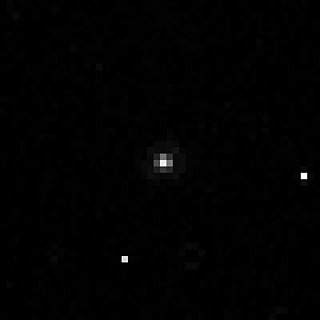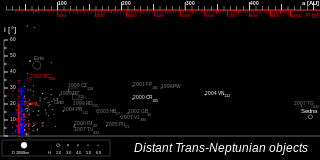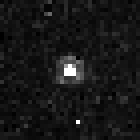In astronomy, a resonant trans-Neptunian object is a trans-Neptunian object (TNO) in mean-motion orbital resonance with Neptune. The orbital periods of the resonant objects are in a simple integer relations with the period of Neptune, e.g. 1:2, 2:3, etc. Resonant TNOs can be either part of the main Kuiper belt population, or the more distant scattered disc population.

(48639) 1995 TL8 is a binary trans-Neptunian object from the scattered disc in the outermost regions of the Solar System. It was discovered by Arianna Gleason in 1995 and measures approximately 176 kilometers in diameter. Its 80-kilometer minor-planet moon, provisionally designated S/2002 (48639) 1, was discovered on 9 November 2002.
(119070) 2001 KP77, provisional designation:2001 KP77, is a resonant trans-Neptunian object in the Kuiper belt, a circumstellar disc located in the outermost region of the Solar System. It was discovered on 23 May 2001, by American astronomer Marc Buie at the Cerro Tololo Observatory in Chile. The object is locked in a 4:7 orbital resonance with Neptune. It has a red surface color and measures approximately 176 kilometers (110 miles) in diameter. As of 2021, it has not been named.
(95625) 2002 GX32, also written as (95625) 2002 GX32, is a trans-Neptunian object that resides in the Kuiper belt. It has a 3:7 resonance with Neptune. It was discovered on April 8, 2002 by Marc W. Buie, Amy B. Jordan, and James L. Elliot.
(118378) 1999 HT11, provisional designation:1999 HT11, is a trans-Neptunian object from the outermost region of the Solar System, locked in a 4:7 orbital resonance with Neptune. It was discovered on 17 April 1999, by astronomers at the Kitt Peak Observatory, Arizona, in the United States. The very red object measures approximately 134 kilometers (83 miles) in diameter. As of 2021, it has not been named.
(91205) 1998 US43, provisional designation 1998 US43, is a resonant trans-Neptunian object of the plutino group, located in the Kuiper belt in the outermost region of the Solar System. The rather bluish body measures approximately 111 kilometers (69 miles) in diameter. It was discovered on 22 October 1998, by American astronomer Marc Buie at the Kitt Peak National Observatory in the United States. It is probably not a dwarf planet candidate.

Detached objects are a dynamical class of minor planets in the outer reaches of the Solar System and belong to the broader family of trans-Neptunian objects (TNOs). These objects have orbits whose points of closest approach to the Sun (perihelion) are sufficiently distant from the gravitational influence of Neptune that they are only moderately affected by Neptune and the other known planets: This makes them appear to be "detached" from the rest of the Solar System, except for their attraction to the Sun.
(523731) 2014 OK394, also known as 1995 SN55, is a trans-Neptunian object that orbits in the outer Solar System beyond the orbit of Neptune. First observed as 1995 SN55 by Spacewatch on 20 September 1995, it was a lost minor planet with an insufficiently defined orbit with only 36 days of observations. On 8 October 2010, it was rediscovered by the Pan-STARRS 1 survey and later announced as 2014 OK394 in July 2016. It was not until November 2020 when amateur astronomers S. Deen and K. Ly identified 2014 OK394 and 1995 SN55 as the same object. This identification was confirmed and announced by the Minor Planet Center in January 2021.

(145480) 2005 TB190, provisionally known as 2005 TB190, is a trans-Neptunian object (TNO) with an absolute magnitude of 4.4.
(131697) 2001 XH255, provisionally known as 2001 XH255, is a trans-Neptunian object (TNO) that has a 4:5 resonance with Neptune.

2003 LA7, also written as 2003 LA7, is a resonant trans-Neptunian object that goes around the Sun once for every four times that Neptune goes around. This means it is in a 1:4 orbital resonance with Neptune. Another example of such object in this resonance is 2011 UP411.

(82075) 2000 YW134, provisional designation: 2000 YW134, is a resonant trans-Neptunian object and binary system, located in the outermost region of the Solar System. It was discovered on 26 December 2000, by astronomers with the Spacewatch survey at Kitt Peak Observatory near Tucson, Arizona. The reddish object stays in a rare 3:8 resonance with Neptune. A smaller companion was discovered by the Hubble Space Telescope in October 2002. As of 2021, neither the primary body nor its satellite have been named.

(528381) 2008 ST291, provisional designation 2008 ST291, is a 1:6 resonant trans-Neptunian object located in the outermost region of the Solar System that takes almost a thousand years to complete an orbit around the Sun. It was discovered on 24 September 2008 by American astronomers Megan Schwamb, Michael Brown and David Rabinowitz at the Palomar Observatory in California, with no known earlier precovery images.

(432949) 2012 HH2 is a resonant trans-Neptunian object, approximately 255 kilometers (160 miles) in diameter, located in the outermost region of the Solar System. It was discovered by Slovak astronomer Tomáš Vorobjov from images taken on the night of 19 April 2012, at the Astronomical Research Institute (H21) in Illinois, United States. This minor planet was numbered (432949) by the Minor Planet Center on 4 April 2015 (M.P.C. 93615). As of 2021, it has not been named.

(60621) 2000 FE8 is a resonant and binary trans-Neptunian object, approximately 146 kilometers (91 miles) in diameter, located in the outermost region of the Solar System. It was discovered on 27 March 2000, by astronomers John Kavelaars, Brett Gladman, Jean-Marc Petit and Matthew Holman at Mauna Kea Observatory on Hawaii. This distant object resides in an eccentric orbit and is locked in a 2:5 orbital resonance with Neptune. It is known to have a 111-kilometer sized companion, which was discovered in January 2007.
2015 KE172, internal designation o5m72, is a distant resonant trans-Neptunian object on an eccentric orbit in the outermost region of the Solar System, approximately 100 kilometers (60 miles) in diameter. It was first observed on 21 May 2015 by astronomers with the Outer Solar System Origins Survey at the Mauna Kea Observatories on the island of Hawaii, United States. It came to perihelion (closest approach to the Sun) in October 2017 at a distance of 44.1 AU (6.60 billion km). Its existence was first released in February 2018, and the observations and orbit were announced on 27 April 2018. It belongs to the most distant resonant objects known to exist.
2014 FC72 is a trans-Neptunian object, classified as a scattered and detached object, located in the outermost region of the Solar System. It was first observed on 24 March 2014 by astronomers with the Pan-STARRS survey at Haleakala Observatory, Hawaii, United States. With its perihelion distant from Neptune, it belongs to a small and poorly understood group of objects with moderate eccentricities. It is estimated to measure 500 kilometers (300 miles) in diameter, assuming a low albedo.
2015 KQ174 is a trans-Neptunian object, both considered a scattered and detached object, located in the outermost region of the Solar System. The object with a moderately inclined and eccentric orbit measures approximately 154 kilometers (96 miles) in diameter. It was first observed on 24 May 2015, by astronomers at the Mauna Kea Observatories in Hawaii, United States.
(495603) 2015 AM281, provisional designation 2015 AM281, is a resonant trans-Neptunian object in the outermost region of the Solar System, guesstimated at approximately 470 kilometers (290 miles) in diameter. It was discovered on 13 March 2010, by astronomers with the Pan-STARRS survey at Haleakala Observatory, Hawaii, United States.
2014 UE228 is a trans-Neptunian object from the outermost region of the Solar System. The object is in a rare 3:8 resonance with Neptune and measures approximately 93 kilometers (58 miles) in diameter. It was first observed on 22 October 2014, by astronomers with the Outer Solar System Origins Survey at the Mauna Kea Observatories, Hawaii, and was provisionally designated 2014 UE228. As of 2021, it has not been numbered.









